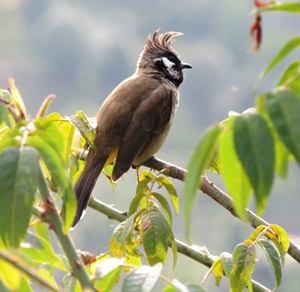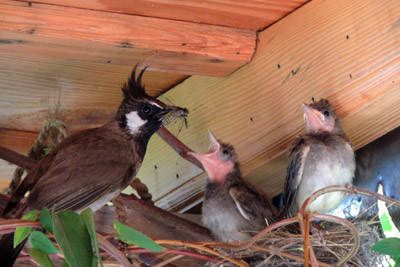Environment
Himalayan Bulbuls Learning to Fly
|
|
Rajiv Butalia spends days watching and filming a pair of Himalayan bulbuls while they build a nest, lay eggs, incubate them and feed the three little chicks that hatch. Finally, the day arrives for their first flight, and the inevitable good-bye to the nest. This has been captured in a memorable video.
Watch Video of baby Himalayan Bulbuls
|
| | |
 The Himalayan Bulbul is a songbird with a distinctive sweet bird call, very different from its irate angry warning when other birds come too close. This species is widely distributed in the Himalayan foothills. Also known as 'White-cheeked Bulbul', a name often used to refer the white-eared bulbul, which is not seen in the Himalayas, Himalayan Bulbul is the preferred name for the species found in the Himalayas, with it's unique forward-pointing crest.
The Himalayan Bulbul is a songbird with a distinctive sweet bird call, very different from its irate angry warning when other birds come too close. This species is widely distributed in the Himalayan foothills. Also known as 'White-cheeked Bulbul', a name often used to refer the white-eared bulbul, which is not seen in the Himalayas, Himalayan Bulbul is the preferred name for the species found in the Himalayas, with it's unique forward-pointing crest.
|
Environment
• Impending Catastrophe
• Spirit of Jungle
• Wild Magic
• Last of Asiatic Lions
• Sacred Groves
• Save the Ganga
• Tomorrow Too Late
• Value Tourism
• Islands
|
 In late spring or early summer, it builds a shallow, bowl-shaped nest of twigs, fibres and leaves, in which it lays its eggs, usually three eggs, which need about 10 days of incubation before they hatch. Two weeks later the chicks are fledged, and able to fly.
In late spring or early summer, it builds a shallow, bowl-shaped nest of twigs, fibres and leaves, in which it lays its eggs, usually three eggs, which need about 10 days of incubation before they hatch. Two weeks later the chicks are fledged, and able to fly.
The word 'Bulbul' is a Persian name for Nightingale. The Bulbul was called Persian Nightingale in an era when Bulbuls were popular cage songsters in Persia, as were Nightingales in the West. They were may eloquent verses about them in Persian poetry.
The hillsides of Kumaon, Uttarakhand are full of these pretty birds. So is our garden. The Himalayan Bulbul is recognised by its distinctive crest, white cheeks and yellow vent.
|
 |
Editor: Romola Butalia (c) India Travelogue. All rights reserved. |
 In late spring or early summer, it builds a shallow, bowl-shaped nest of twigs, fibres and leaves, in which it lays its eggs, usually three eggs, which need about 10 days of incubation before they hatch. Two weeks later the chicks are fledged, and able to fly.
In late spring or early summer, it builds a shallow, bowl-shaped nest of twigs, fibres and leaves, in which it lays its eggs, usually three eggs, which need about 10 days of incubation before they hatch. Two weeks later the chicks are fledged, and able to fly. The Himalayan Bulbul is a songbird with a distinctive sweet bird call, very different from its irate angry warning when other birds come too close. This species is widely distributed in the Himalayan foothills. Also known as 'White-cheeked Bulbul', a name often used to refer the white-eared bulbul, which is not seen in the Himalayas, Himalayan Bulbul is the preferred name for the species found in the Himalayas, with it's unique forward-pointing crest.
The Himalayan Bulbul is a songbird with a distinctive sweet bird call, very different from its irate angry warning when other birds come too close. This species is widely distributed in the Himalayan foothills. Also known as 'White-cheeked Bulbul', a name often used to refer the white-eared bulbul, which is not seen in the Himalayas, Himalayan Bulbul is the preferred name for the species found in the Himalayas, with it's unique forward-pointing crest.